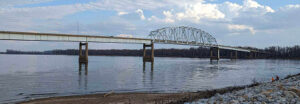
When floods this year swept through Ludlow, Vermont, the town had a big problem. Not only did flood waters carry away cars and push mud and debris into homes — they also overwhelmed the town’s wastewater treatment plant, sending sewage into a nearby river.
As storms become more intense and frequent, events like this will be more common.
Though often viewed as separate issues, flooding and water quality go hand in hand. Unfortunately, many agencies plan for and address flooding and water quality problems independently, or overlook flooding altogether.
By pursuing both flood resilience and clean water together, communities can become cleaner, safer, and more resilient.
The overlap of flooding and water quality
Through our work with leaders and practitioners on the ground, the American Flood Coalition sees how water quality and flooding are inseparable.
As floods carry excess pollutants from farms, factories, and cities into rivers and lakes, they can trigger algal blooms that produce dangerous toxins. These pollutants also strain water treatment plants, compromising the quality of drinking water. And when it rains hard enough, floodwaters erode soils, dumping excess dirt into streams or rivers and changing habitats for fish and other organisms.
Fortunately, flood solutions that consider both water quality and flooding exist.
One example is Washington, D.C.’s Northeast Boundary Tunnel. The 5.1-mile underground tunnel was built to handle D.C.’s aging sewer system, which often overflowed into the Anacostia River during rainstorms. During its first major storm since it was completed, the tunnel prevented 267 million gallons of stormwater and sewage from spilling into the river.
Another example that tackles both flooding and water quality is North Miami’s Good Neighbor Stormwater Park. In 2019, the city redeveloped a half-acre vacant lot, adding a pond that holds excess water, a pipe that brings water to the pond, and a marsh that absorbs rainfall. Holding 20 times more water than the vacant lot before, the new park prevents stormwater runoff into surrounding waterways.
Changing the system
By addressing flood resilience and water quality together, entities not only tackle two problems at once; they also save money by using taxpayer dollars more efficiently. Unfortunately, most projects are not rewarded for tackling both water quality and flooding.
Change how projects are funded
To incentivize such projects, the federal government should change how it determines the projects they fund. Many federal grant programs score the benefits of flood resilience or water quality, but not both. This means that communities can usually apply to only one source of funding.
In practice, if a local government wanted to fund a wetlands project, it would either apply for money from the EPA (if the wetlands served to filter pollution) or for money from FEMA (if the wetlands served to buffer against flooding). But because wetlands can both improve water quality and protect against flooding, multiple sources of funding should be in play.
One example of a city successfully combining funding sources is the West Edge District redevelopment project in Cheyenne, Wyoming. The city combined $3 million from FEMA with $2.2 million from the EPA (along with $1.7 million from the Economic Development Administration and another $4.8 million in local funding) to build a new stormwater park that improves the movement, drainage, and retention of stormwater.
Change how agencies work together
When planning a project, agencies must coordinate with each other to ensure they consider flood resilience and water quality. For example, the D.C. Department of Energy and Environment partnered with the Homeland Security and Emergency Management Agency and others to develop a series of parks in southwest D.C. that absorb rainwater and slow runoff during storms. The parks both decrease flooding in surrounding neighborhoods and reduce pollutants being carried into the nearby river.
To enable broader, long-term strategies, state and local governments should also empower a leader with permanent staff to establish flood resilience priorities across agencies, data, and budgets, while also considering water quality.
One such example of a centralized, empowered agency responsible for prioritizing flood resilience is the Kentucky Department of Environmental Protection’s Division of Water. The division manages both water quality and quantity, ensuring clean drinking water, protecting waterways from runoff pollution, and monitoring hydrologic conditions to prepare for flooding and drought.
Change how current structures work
Finally, states should use existing structures to boost flood resilience. Many states already use regional entities to manage water quality or supply. With these same resources, these entities should align on watershed boundaries and consider flood resilience to more effectively manage water resources across the state.
Some regional programs have successfully grouped flood resilience, water quality, and water quantity together. The Southwest Florida Water Management District, for example, models and evaluates watersheds on how well they provide not just clean water but also flood protection and adequate water supply. By looking at these characteristics together, the district helps local governments develop project plans and broader strategies that address multiple challenges within an entire watershed.
One program in this district that tackles both water quality and flooding is a road project in Auburndale, Florida. The program, which came from a partnership between the city and the district, converted a four-lane road to a two-lane road, adding channels with plants, called bioswales. These bioswales act as rain gardens, reducing and filtering stormwater runoff.
Similarly, through its Iowa Watershed Approach program, the Iowa Flood Center formed Watershed Management Authorities across nine watersheds. IFC works with landowners to identify the best places for projects to absorb rainfall and reduce downstream flooding and water pollution.
Connecting water quality and flood resilience
To deal with these challenges, governments at all levels must think about water quality and flood resilience together. As storms and flooding get more frequent and intense, compounding problems like pollution will only increase.
The American Flood Coalition will continue working with communities on the ground to build resilience against flooding and all that comes with it.
—
This article was co-authored by Gian Tavares, AFC Associate Strategy Director, and Brandon Pytel, AFC Communications Associate.






